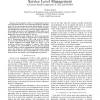Free Online Productivity Tools
i2Speak
i2Symbol
i2OCR
iTex2Img
iWeb2Print
iWeb2Shot
i2Type
iPdf2Split
iPdf2Merge
i2Bopomofo
i2Arabic
i2Style
i2Image
i2PDF
iLatex2Rtf
Sci2ools
BDIM
2007
IEEE
2007
IEEE
Frameworks for Business-driven Service Level Management: A Criteria-based Comparison of ITIL and NGOSS
—In the majority of today’s IT organizations, Service Level Agreements (SLAs) are an important means for underpinning IT service provisioning by clearly defined Quality of Service (QoS) parameters as well as service costs and violation penalties. The management of those SLAs is the main subject addressed by the discipline of Service Level Management (SLM) which covers several activities vital for the deployment of customer-oriented, high-quality and well-performing IT services. This paper analyzes and compares two of the most important SLM frameworks available in business-driven IT Management: the IT Infrastructure Library (ITIL) with its SLM reference process and the NGOSS SLA Management Handbook. In order to deliver significant and helpful results, we derive a set of evaluation criteria from a realistic IT scenario. These criteria are applied to ITIL and NGOSS in order to elaborate possible areas of conflict as well as complementary fields and unaddressed issues. The results ...
| Added | 02 Jun 2010 |
| Updated | 02 Jun 2010 |
| Type | Conference |
| Year | 2007 |
| Where | BDIM |
| Authors | Thomas Schaaf |
Comments (0)

